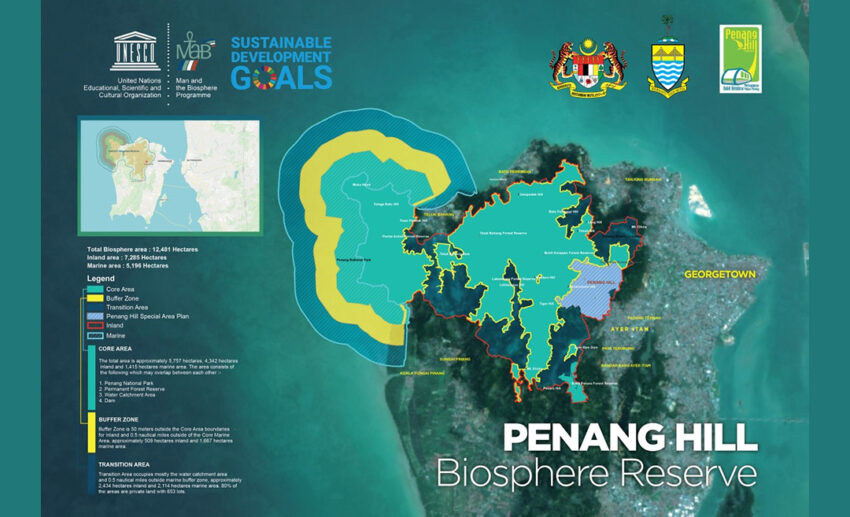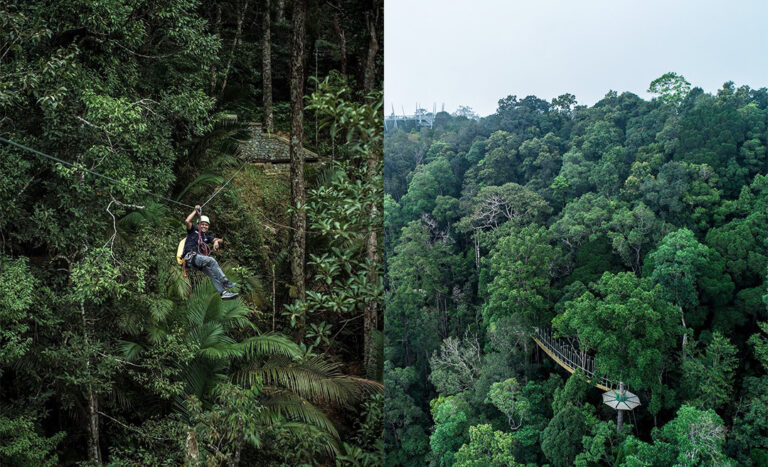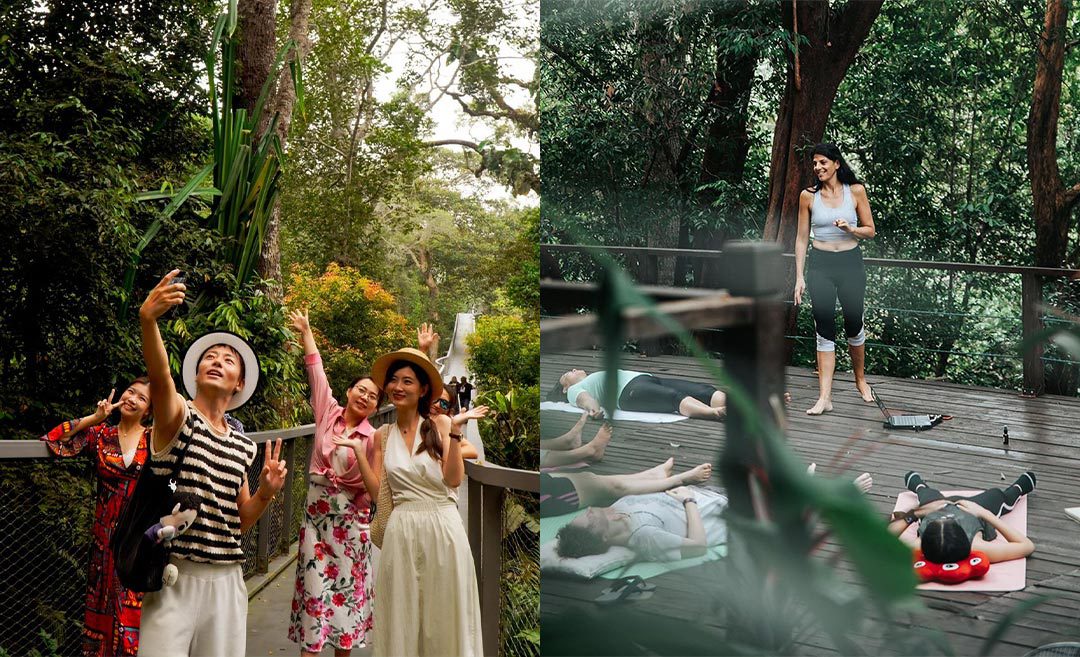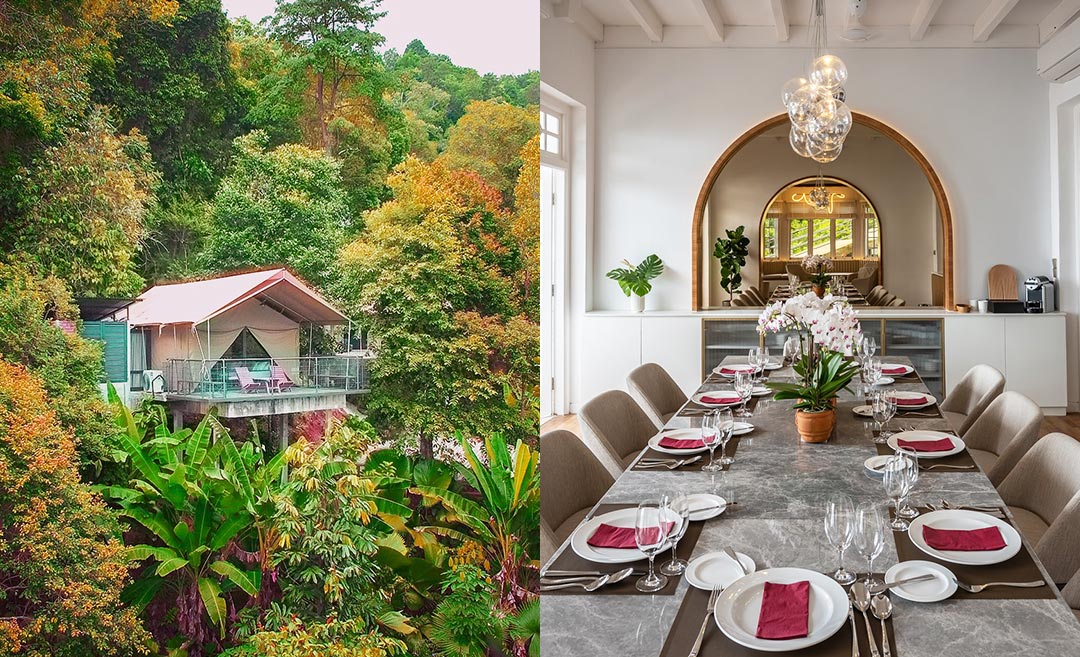Penang Hill, or Bukit Bendera, offers an escape into a cooler climate, a natural respite from George Town’s bustling streets. This hill station, nestled 833 meters above sea level, is recognized as a UNESCO Biosphere Reserve. Penang Hill promises stunning vistas, unique flora and fauna, and a unique blend of historical and modern attractions.

Ascending Penang Hill begins at the foot of the hill in Air Itam. The Penang Hill Funicular Railway, one of the world’s steepest, swiftly transports visitors to the peak. This journey showcases expansive views of George Town, Butterworth, and, on clear days, even the distant island of Langkawi!
Things to do in Penang Hill
Curtis Crest Treetop Walk
At the summit, the Curtis Crest Treetop Walk awaits. Named after Charles Curtis, a renowned 19th-century botanist, this 100-meter circular walkway stands as Penang’s highest viewing platform. Here, visitors can marvel at unobstructed views of the island and its surroundings.
The Habitat
The Habitat, a rainforest discovery centre, invites visitors on a journey through the canopy. Walkways wind through the forest, offering glimpses of playful monkeys, colourful birds, and elusive flying squirrels. The Langur Way Canopy Walk, two 115-meter-long bridges suspended 40 meters above the forest floor, provides an unparalleled perspective of the rainforest ecosystem. Informative panels along the trails offer insights into various species and the ecosystem.
It is a botanist’s paradise. Penang Hill’s dominant forest type is the hill dipterocarp, while higher elevations boast submontane oak-laurel and even coniferous trees, an unusual sight in this tropical region. The presence of tree ferns further adds to the hill’s unique botanical character.
Known as a type site for many Malaysian plant species, Penang Hill has been a focal point for botanical studies. Its rich biodiversity includes a number of endemic species, some on the brink of extinction. The parasitic Exorhopalia ruficeps thrives in the damp undergrowth, while the stunning Penang Slipper Orchid faces the threat of over-collection. Conservation efforts have successfully reintroduced the endangered Maingaya malayana witch hazel.
Penang Hill is also a haven for wildlife, especially for those with a keen eye for observation. While large mammals are absent, the hill teems with smaller creatures. Squirrels, monkeys, and tree shrews are common sights, while more elusive inhabitants like civets, flying lemurs, and bats prefer the cover of night.
Birdwatchers will be delighted by the diverse avian population. Over 100 species have been recorded, ranging from familiar garden birds to rare forest dwellers. Keep an ear out for the enchanting chorus of cicadas and crickets as the sun begins to set.
For the truly adventurous, a lucky encounter with the Dusky Leaf Monkey, Black Giant Squirrel, or Greater Racked-Tailed Drongo is a possibility. These rare creatures can sometimes be spotted during mid-morning and late afternoon.
Remember to look up and around; the forest canopy is home to fascinating creatures like stick insects and leaf mantises.
Kopi Hutan
If you’re looking for a quieter retreat, Kopi Hutan, Penang’s highest café, offers a serene escape amidst lush greenery. Enjoy a cup of coffee while taking in the stunning views. Accessible by buggy or a scenic 1.5 km walk from the funicular, Kopi Hutan is a hidden gem run by a friendly local couple and features a simple yet charming menu. It’s slightly removed from the main tourist areas, providing a serene spot to enjoy a cup of coffee while soaking in the natural surroundings.
Cliff Café (Astaka Bukit Bendera)
Penang Hill’s rich history is evident in its colonial architecture. The Cliff Café, or Astaka Bukit Bendera, is a three-story food court offering a taste of local delicacies like laksa, char kway teow, and rojak.
David Brown’s Restaurant & Tea Terrace
For a more refined experience, David Brown’s Restaurant & Tea Terrace, housed in a historic building, serves English fare and high tea with panoramic views. A retreat since colonial times, the hill now blends historical charm with modern attractions. Today, remnants of its colonial past blend with modern attractions, creating a rich tapestry of history and nature.
Monkey Cup Garden
Another unique attraction is the Monkey Cup Garden, which is dedicated to pitcher plants. These fascinating plants, with their modified leaves that trap insects, are rare sights in many parts of the world. The garden showcases local varieties from Malaysia and Indonesia, as well as species from Madagascar and Brazil.
Hiking via numerous trails
Adventurous visitors might prefer hiking to Penang Hill via one of its many trails. The Heritage Trail, starting behind the Lower Station, is the most popular and easiest, winding 4 kilometres along the railway track. The Moon Gate Trail, starting near the Botanical Gardens, offers a more challenging 6-kilometer trek through scenic rainforest. Other trails like the Jeep Track, Batu Gantung, and Moniot Trail cater to different fitness levels and preferences, each providing unique perspectives of the hill’s natural beauty.
Entry fees and tips on exploring Penang Hill
The funicular railway operates from 6:30am to 11pm daily, with a ticket costing RM30 for non-locals. To avoid long queues, consider purchasing the fast pass for the funicular, especially during peak hours. The Habitat opens from 9am to 6:30pm, with an entry fee of RM60. Other attractions like the Monkey Cup Garden and Kopi Hutan follow similar schedules, ensuring visitors have ample time to explore.
If visiting on a weekend, it’s advisable to get the fast pass for the funicular railway. Although it costs RM40 (RM28 more than the regular pass for locals), it allows you to skip the long queues, saving significant time, especially during busy periods.
Penang Hill stands out as a destination that balances natural beauty, historical charm, and modern convenience. Whether one seeks adventure, tranquillity, or a bit of both, Penang Hill offers an enriching experience, making it a must-visit in Penang.



